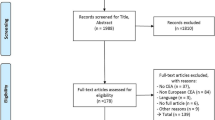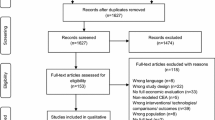Abstract
Purpose
To estimate the cost-effectiveness of breast cancer screening in the National Breast and Cervical Cancer Early Detection Program (NBCCEDP).
Methods
Using a modified CISNET breast cancer simulation model, we estimated outcomes for women aged 40–64 years associated with three scenarios: breast cancer screening within the NBCCEDP, screening in the absence of the NBCCEDP (no program), and no screening through any program. We report screening outcomes, cost, quality-adjusted life-years (QALYs), incremental cost-effectiveness ratios (ICERs), and sensitivity analyses results.
Results
Compared with no program and no screening, the NBCCEDP lowers breast cancer mortality and improves QALYs, but raises health care costs. Base-case ICER for the program was $51,754/QALY versus no program and $50,223/QALY versus no screening. Probabilistic sensitivity analysis ICER for the program was $56,615/QALY [95% CI $24,069, $134,230/QALY] versus no program and $51,096/QALY gained [95% CI $26,423, $97,315/QALY] versus no screening.
Conclusions
On average, breast cancer screening in the NBCCEDP was cost-effective compared with no program or no screening.


Similar content being viewed by others
References
Bleyer A, Welch HG (2012) Effect of three decades of screening mammography on breast-cancer incidence. New Engl J Med. 367:1998–2005
Mandelblatt JS, Cronin KA, Bailey S et al (2009) Effects of mammography screening under different screening schedules: model estimates of potential benefits and harms. Ann Intern Med 151:738–747
Melnikow J, Tancredi DJ, Yang Z et al (2013) Program-specific cost-effectiveness analysis: breast cancer screening policies for a safety-net program. Value Health. 16:932–941
Practice bulletin no. 122: Breast cancer screening. Obstet Gynecol. 118:372–82
Oeffinger KC, Fontham ET, Etzioni R et al (2015) Breast cancer screening for women at average risk: 2015 guideline update from the American Cancer Society. JAMA 314:1599–1614
Siu AL (2016) Screening for breast cancer: U.S. Preventive Services Task Force Recommendation Statement. Ann Intern Med 164:279–296
Halpern MT, Ward EM, Pavluck AL, Schrag NM, Bian J, Chen AY (2008) Association of insurance status and ethnicity with cancer stage at diagnosis for 12 cancer sites: a retrospective analysis. Lancet Oncol. 9:222–231
Ward E, Halpern M, Schrag N et al (2008) Association of insurance with cancer care utilization and outcomes. CA Cancer J Clin 58:9–31
Lipscomb J, Fleming ST, Trentham-Dietz A et al (2016) What Predicts an advanced-stage diagnosis of breast cancer? Sorting out the influence of method of detection, access to care, and biologic factors. Cancer Epidemiol Biomark Prev 25:613–623
National Breast and Cervical Cancer Early Detection Program (NBCCEDP) [cited 2018 March 14, 2018]; https://www.cdc.gov/cancer/nbccedp/about.htm
Miller JW, Hanson V, Johnson GD, Royalty JE, Richardson LC (2014) From cancer screening to treatment: service delivery and referral in the National Breast and Cervical Cancer Early Detection Program. Cancer 120(Suppl 16):2549–2556
Hoerger TJ, Ekwueme DU, Miller JW et al (2011) Estimated effects of the National Breast and Cervical Cancer Early Detection Program on breast cancer mortality. Am J Prev Med 40:397–404
White MC, Wong FL (2015) Preventing premature deaths from breast and cervical cancer among underserved women in the United States: insights gained from a national cancer screening program. Cancer Causes Control 26:805–809
Richardson LC, Royalty J, Howe W, Helsel W, Kammerer W, Benard VB (2010) Timeliness of breast cancer diagnosis and initiation of treatment in the National Breast and Cervical Cancer Early Detection Program, 1996–2005. Am J Public Health 100:1769–1776
Ekwueme DU, Subramanian S, Trogdon JG et al (2014) Cost of services provided by the National Breast and Cervical Cancer Early Detection Program. Cancer 120(Suppl 16):2604–2611
Briggs A, Claxton K, Schulper M (2006) Decision modelling for health economic evaluation. Oxford University Press, Oxford
Neumann PJ, Sanders GD, Russell LB, Siegel JE, Ganiats TG (2017) Cost-effectiveness in health and medicine, 2nd edn. Oxford University Press, Oxford
Cronin KA, Yu B, Krapcho M et al (2005) Modeling the dissemination of mammography in the United States. Cancer Causes Control 16:701–712
Feuer EJ (2006) Modeling the impact of adjuvant therapy and screening mammography on U.S. breast cancer mortality between 1975 and 2000: introduction to the problem. J Natl Cancer Inst Monogr. 2006(36):2–6
Plevritis SK, Salzman P, Sigal BM, Glynn PW (2007) A natural history model of stage progression applied to breast cancer. Stat Med 26:581–595
Holford TR, Cronin KA, Mariotto AB, Feuer EJ (2006) Changing patterns in breast cancer incidence trends. J Natl Cancer Inst Monogr. 2006(36):19–25
Cronin KA, Mariotto AB, Clarke LD, Feuer EJ (2006) Additional common inputs for analyzing impact of adjuvant therapy and mammography on US mortality. J Natl Cancer Inst Monogr. 2006(36):26–29
Mariotto AB, Feuer EJ, Harlan LC, Abrams J (2006) Dissemination of adjuvant multiagent chemotherapy and tamoxifen for breast cancer in the United States using estrogen receptor information: 1975–1999. J Natl Cancer Inst Monogr 2006(36):7–15
Allaire BT, Ekwueme DU, Hoerger TJ et al (2018) Cost-effectiveness of patient navigation for breast cancer screening in the National Breast and Cervical Cancer Early Detection Program. (under review)
Raich PC, Whitley EM, Thorland W, Valverde P, Fairclough D (2012) Patient navigation improves cancer diagnostic resolution: an individually randomized clinical trial in an underserved population. Cancer Epidemiol Biomark Prev 21:1629–1638
Hoffman HJ, LaVerda NL, Young HA et al (2012) Patient navigation significantly reduces delays in breast cancer diagnosis in the District of Columbia. Cancer Epidemiol Biomark Prev 21:1655–1663
Ekwueme DU, Subramanian S, Khushalani JS, Miller JW, Wong FF, Trogdon JG. Economic Cost of the National Breast and Cervical Cancer Early Detection Program (under review)
Mariotto AB, Yabroff KR, Shao Y, Feuer EJ, Brown ML (2011) Projections of the cost of cancer care in the United States: 2010–2020. J Natl Cancer Inst 103:117–128
Fireman BH, Quesenberry CP, Somkin CP et al (1997) Cost of care for cancer in a health maintenance organization. Health Care Financ Rev. 18:51–76
Zuckerman S, Williams A, Stockley K (2009) Trends in medicaid physician fees, 2003–2008. Health Aff 28(3):W510–W519
Yabroff KR, McNeel TS, Waldron WR et al (2007) Health limitations and quality of life associated with cancer and other chronic diseases by phase of care. Med Care 45:629–637
Cho H, Howlader N, Mariotto A, Cronin K (2011) Estimating relative survival for cancer patients from the SEER Program using expected rates based on Ederer I versus Ederer II method. Surveillance Research Program, NCI, Technical Report #2011-01. http://surveillance.cancer.gov/reports/tech2011.01.pdf. Accessed 26 Feb 2017
Howard DH, Ekwueme DU, Gardner JG, Tangka FK, Li C, Miller JW (2010) The impact of a national program to provide free mammograms to low-income, uninsured women on breast cancer mortality rates. Cancer 116:4456–4462
Howard DH, Tangka FK, Royalty J et al (2015) Breast cancer screening of underserved women in the USA: results from the National Breast and Cervical Cancer Early Detection Program, 1998–2012. Cancer Causes Control 26:657–668
Subramanian S, Ekwueme DU, Gardner JG, Bapat B, Kramer C (2008) Identifying and controlling for program-level differences in comparative cost analysis: lessons from the economic evaluation of the National Breast and Cervical Cancer Early Detection Program. Eval Program Plann. 31:136–144
Jemal A, Ward EM, Johnson CJ et al (2017) Annual report to the nation on the status of cancer, 1975–2014, featuring survival. J Natl Cancer Inst 109(9):djx030
Cohen RA, Zammitti EP, Martinez ME (2017) Health insurance coverage: early release of estimates from the National Health Interview Survey, 2016. Centers for Disease Control and Prevention, National Center for Health Statistics, Atlanta
Frean M, Gruber J, Sommers BD (2017) Premium subsidies, the mandate, and medicaid expansion: coverage effects of the affordable care act. J Health Econ. 53:72–86
Henry J (2018) Kaiser Family Foundation. Current status of state medicaid expansion decisions. https://www.kff.org/health-reform/slide/current-status-of-the-medicaid-expansion-decision/
Trogdon JG, Ekweume DU, Subramanian S, Crouse W (2014) Economies of scale in federally-funded, state-organized public health programs: results from the National Breast and Cervical Cancer Early Detection Programs. Health Care Manag Sci 17(4):321–330. https://doi.org/10.1007/s10729-013-9261-z
Acknowledgments
The authors thank Wesley Crouse for his assistance in data collection.
Disclaimer
The findings and conclusions in this paper are those of the authors and do not necessarily represent the official position of the Centers for Disease Control and Prevention (CDC).
Funding
This research was supported by Contract No. 200-2008-27958 from the Centers for Disease Control and Prevention.
Author information
Authors and Affiliations
Corresponding author
Additional information
Publisher's Note
Springer Nature remains neutral with regard to jurisdictional claims in published maps and institutional affiliations.
Electronic supplementary material
Below is the link to the electronic supplementary material.
Rights and permissions
About this article
Cite this article
Rim, S.H., Allaire, B.T., Ekwueme, D.U. et al. Cost-effectiveness of breast cancer screening in the National Breast and Cervical Cancer Early Detection Program. Cancer Causes Control 30, 819–826 (2019). https://doi.org/10.1007/s10552-019-01178-y
Received:
Accepted:
Published:
Issue Date:
DOI: https://doi.org/10.1007/s10552-019-01178-y




